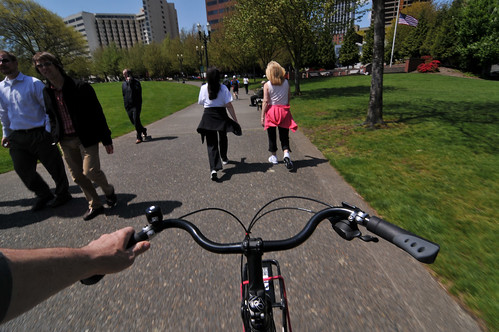
Southeast Portland resident Anthony Thompson is a courteous and cautious bike rider. He’s one of thousands of people who rely on the paths along the Willamette River to get them where they need to go every day. Anthony’s daily commute entails sharing the paths in Waterfront Park with a wide range of other types of users — from people walking, to all manner of human-powered vehicles.
Yesterday he experienced something that I’m sure all of us who have ridden these paths have thought about. I’ve decided to share his story in his words, because I think it highlights some very important issues (emphases are mine):
“I commute from the SE daily and ride the waterfront regularly. When I ride the waterfront I consciously keep my speed down and try and set a safe pace. I’m pretty much the slowest rider and I rarely pass another cyclist. Even so, I hit and almost ran over a little girl with my bike yesterday afternoon. I was riding along slowly, carefully avoiding pedestrians and then suddenly a little girl about 10 feet in front of me leaves her family and bolts for the seawall to look at the river.
Just before I came to a complete stop she collided with the front of my bike and fell to her knees. Her thigh was just about to go under my
chainring and crankset. Luckily she was able to jump up and run into her Dad’s arms. I threw my bike aside and rushed over to see if she
was OK. She was crying hysterically, and I felt more than horrible.Thankfully after a couple minutes she stopped crying and other than a small bump on her forehead, and a grease imprint of my chainring on
her leg, she was OK. I apologized profusely. I think they were visiting from somewhere in Europe. What a horrible way to welcome this family to Portland.What would of happened if I was going just a little bit faster? I kept playing through horrible alternate outcomes in my head. She could of hit her head on the ground, and suffered serious head/brain injuries. I could of gouged her eye out with my brake levers. What a miserable experience.
What I do know is that my slow rate of speed is what saved me and this little girl from something worse.”
Thank you for sharing this story Anthony.
So often, this issue is framed in a way that focuses on how people on bikes simply need to slow down and be more courteous to others. I agree that’s true; but what Anthony’s story illustrates is that even when someone on a bike is operating safely, the potential for this type of incident remains. This is yet another example of how inadequate bicycle access leads to unsafe conditions, and then the consequences of those conditions are then blamed on people who bike (sound familiar?).
The City of Portland missed a huge opportunity to create good bike access near Waterfront Park when they failed to create quality bikeway in the $10 million Naito Parkway rehab project. I have confidence if that project were designed a few years later, we would have a physically separated bikeway through the park today. Instead, people who choose to ride a bike are faced with two bad options: Ride among tourists and people strolling leisurely on the riverfront (as they should be); or ride in a 1990s-style, narrow bike lane on a high-speed, four lane auto thoroughfare. Many people choose the former because riding that close to auto traffic is very unpleasant.
The Bureau of Transportation knows these crowded paths are a big issue (a fatal collision on a popular path in Texas in 2010 added urgency). They’ve done some “Share the Path” outreach and education work and there’s an ongoing coalition of advocates and staff from PBOT and Portland Park & Recreation discussing the Waterfront path issues. (I’m trying to track down an update on that group’s work.)
I applaud the education efforts; but I am skeptical of how much impact they can have. Just like the issues on Broadway/Flint/Wheeler, education and even enforcement yield limited returns when the true culprit is poor facility design. Visitors from other countries and people who just bike to work and don’t pay attention to (or care) about City outreach efforts, will be hard to educate. We need to expand the width of these paths to handle more capacity and we need to separate people on foot from those using bicycles.
Vancouver BC does this on their waterfront:

There’s more than enough room in Waterfront Park to build a new path.
Thankfully, PBOT is planning Portland’s first path that will separate walking and biking traffic on their South Waterfront Greenway Trail project. But the Waterfront is where we need help today.
Why don’t we approach this problem the same way we do when a portion of a freeway has safety and capacity issues? Safety and capacity are the key rationale for spending billions on the Columbia River Crossing, the I-5 widening at the Rose Quarter, the I-84 widening in east Portland, and so on. The Waterfront paths are non-motorized freeways. As such, they deserve the same engineering, financial, and political respect. Until they do, I’m afraid we will hear more stories like Anthony’s.


